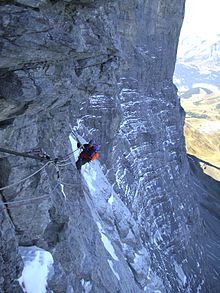Alpine climbing
This article does not cite any sources. (March 2019) |

Alpine climbing (German: Alpinklettern) is a branch of climbing in which the primary aim is very often to reach the summit of a mountain. In order to do this high rock faces or pinnacles requiring several lengths of climbing rope must be ascended. Often mobile, intermediate climbing protection has to be used in addition to the pitons usually in place on the climbing routes.
Alpine tours may be free (pitons, belay devices, slings are only used for safety, not to climb), aid climbing (i.e. all aids are used to assist the climb), clean (all protection devices are placed during the climb and then removed again) or free solo (no protection). A big wall may refer to a route which cannot be climbed within a day or a route which is primarily a rock climb. In addition, ice climbing is often a component of an alpine climb.
As the climbers are on wholly or partly on their own, depending on the availability and extent of routes in Alpine climbs, careful route planning and selection, and knowledge of anchor techniques and the laying of mobile protection devices, abseil and rescue techniques are required. Although most Alpine climbing is free, it may be necessary to use aid climbing, at points where there is no free climbing option, in order to avoid losing time and endangering the rope team.
In the 1980s, Alpine sport climbing was developed as a form of Alpine climbing, thanks to increasingly sophisticated equipment with better performance especially in the sport climbing field. In Alpine sport climbing the aim is to increasingly raise the bar even on multi-rope routes.
See also[]
References[]
Sources[]
- Climbing